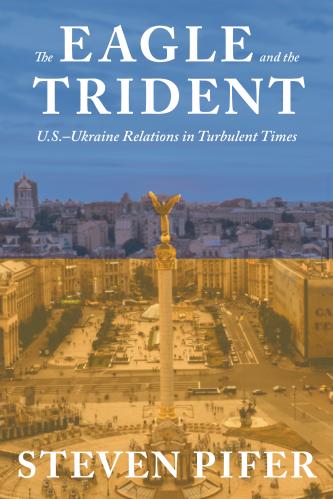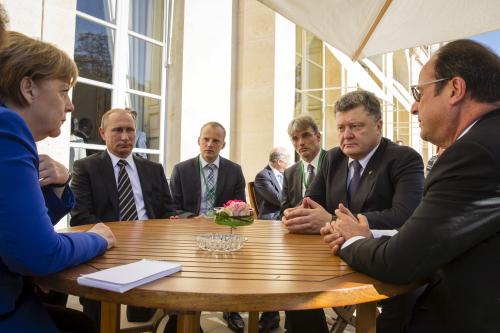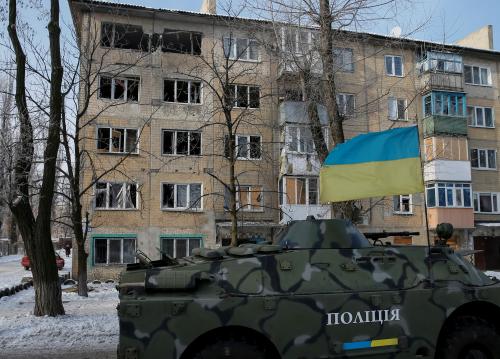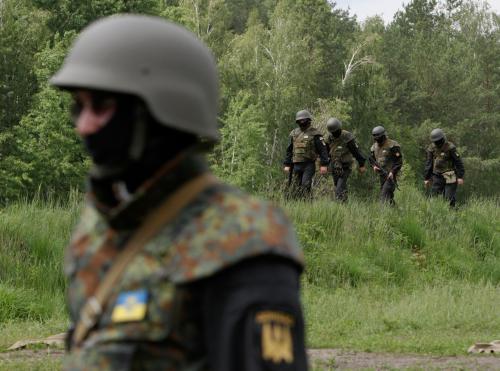As the Ukraine-Russia conflict in the eastern Ukrainian region of Donbas enters its fourth year, the line of contact separating Ukrainian and Russian/separatist forces is hardening. Nothing suggests the sides will soon make significant progress on implementing the Minsk II settlement agreement, reached more than two years ago. Instead, the simmering—not yet frozen—conflict in Donbas appears to be settling in for the long run.
Minsk II is not succeeding
German Chancellor Merkel and French President Hollande brokered the Minsk II accord between Ukrainian President Poroshenko and Russian President Putin in February 2015. Minsk II envisaged a ceasefire and withdrawal of heavy weapons away from the line of contact, followed by a series of political measures to resolve the conflict and restore Ukrainian sovereignty over all of Donbas. While both sides have violated the accords, observers, including the Organization for Security and Cooperation in Europe’s special monitoring mission, place more of the blame on the Russian/separatist side for the failure of the ceasefire to take firm hold.
While Minsk II has not succeeded in resolving the Donbas conflict, it may have been successful in one sense. The West has tied its sanctions on Russia to implementation of Minsk II, implicitly signaling that new Russian aggression could trigger new sanctions. That threat could have restrained the Kremlin from other actions against Ukraine.
That said, Moscow has shown little interest in resolving the Donbas conflict. There is no doubt that it could enforce a ceasefire and withdrawal of heavy weapons on the separatist forces under its control if it wanted. It has chosen not to do so. By all appearances, the Kremlin prefers a simmering conflict that it can use to put pressure on and destabilize the Ukrainian government, in order to make it harder for that government to succeed. That is part of Moscow’s effort to keep Ukraine in a Russian sphere of influence.
By all appearances, the Kremlin prefers a simmering conflict that it can use to put pressure on and destabilize the Ukrainian government.
The Kremlin leadership has used this tactic before to maintain its position in the post-Soviet space. Russian support and, when necessary, Russian military units have sustained frozen conflicts in Transnistria, Abkhazia, and South Ossetia to influence Moldova and Georgia. Those conflicts date back to the early 1990s.
The leaders of the so-called “Donetsk People’s Republic” and “Luhansk People’s Republic” (the unrecognized statelets known by their Russian acronyms, DNR and LNR) apparently wish to join that group. They regularly have rejected reassertion of Ukrainian sovereignty, which is a primary objective of Minsk II.
A growing divide
Over the past three years, the DNR and LNR have drawn closer economically to Russia. Both now use the ruble as their currency, and Russia has moved to take control of economic assets in the two areas. In February, the Russian government announced that it would recognize DNR and LNR passports for travel purposes. The Kremlin spokesperson said that the passports were not passports of officially recognized states, a distinction that would seem to hold little meaning if people in the DNR and LNR can travel—at least to Russia—on those documents.
Moscow has evinced no interest in annexing the DNR and LNR, as it swiftly did with Crimea in 2014. Moreover, it has stopped short of recognizing the two people’s republics as independent states, as it did with Abkhazia and South Ossetia in 2008. Russian actions are, however, widening the chasm in Donbas, not helping to find a settlement.
Certain Ukrainian actions are also hardening the line of contact. Kyiv stopped wiring pension payments to banks in the occupied areas in 2015, when the DNR and LNR began taking a large cut as “taxes.” That was understandable: The Ukrainian government had no interest in financing separatist structures and actions in Donbas.
Earlier this year, Kyiv replaced an unofficial blockade along the line of contact with an official embargo of trade with the Russian/separatist-controlled parts of Donbas. On April 25, Ukraine’s state power company cut the supply of electricity to the LNR, citing mounting unpaid bills. There is speculation that the DNR may face a cut-off as well.
With Russia pulling the LNR and DNR away from Ukraine, even if it does not wish to annex those regions, Kyiv is taking steps to shift as much of the economic burden of sustaining the occupied part of Donbas on to Russian state coffers as possible. Ukraine’s government is seeking to raise the costs to Moscow of Russia’s continuing occupation of, and support for separatists in, Donbas.
To keep or not to keep Donbas
As these developments proceed, more Ukrainians question whether it is time to let Donbas—those parts of it that are now occupied—go. Holding on ultimately would entail huge costs for the Ukrainian budget to repair housing, infrastructure, and industry damaged during three years of fighting. It would also require a major push to reintegrate the population. One of Kyiv’s failings has been the absence of a serious outreach effort to those caught behind LNR and DNR lines, to make them feel that they would be fully welcomed back as citizens of Ukraine once Ukrainian sovereignty was restored.
[T]he conflict in Ukraine’s east is not moving toward settlement; it is moving toward stasis.
No major Ukrainian leader advocates letting Donbas go, and the idea thus far receives support from only a minority of Ukrainians. Moreover, a decision to let Donbas go would not solve the Ukraine-Russia conflict. Moscow does not want Donbas; it wants leverage, leverage that the Kremlin believes Donbas provides for its bid to exert influence over all of Ukraine.
Unfortunately, the conflict in Ukraine’s east is not moving toward settlement; it is moving toward stasis. As the Trump administration reviews its policy toward Ukraine, it needs to take that into account. It has to work with U.S. partners in Europe to develop policy tools that will maintain—and sharpen—pressure on Russia in order to persuade the Kremlin that it is time for a real change in Russia’s course.








Commentary
Deepening division in Donbas
May 2, 2017